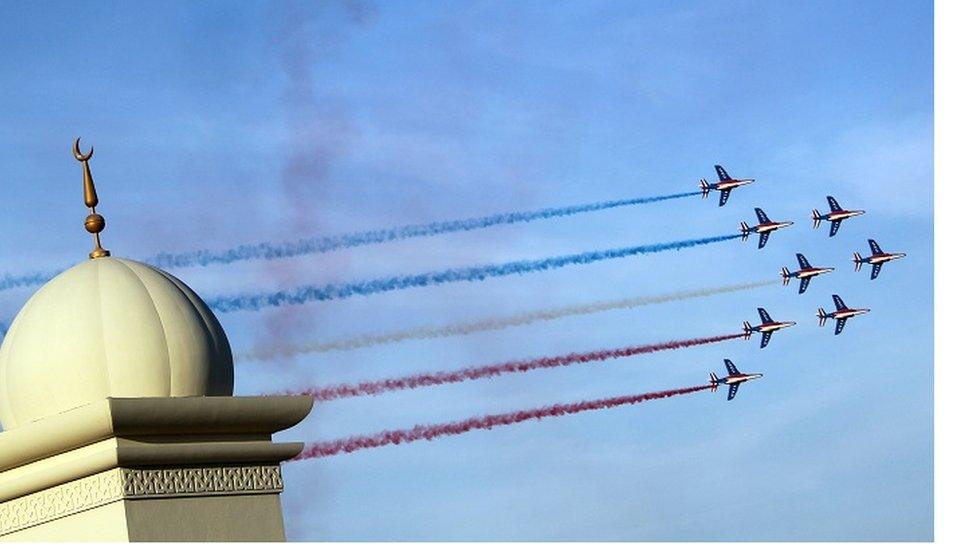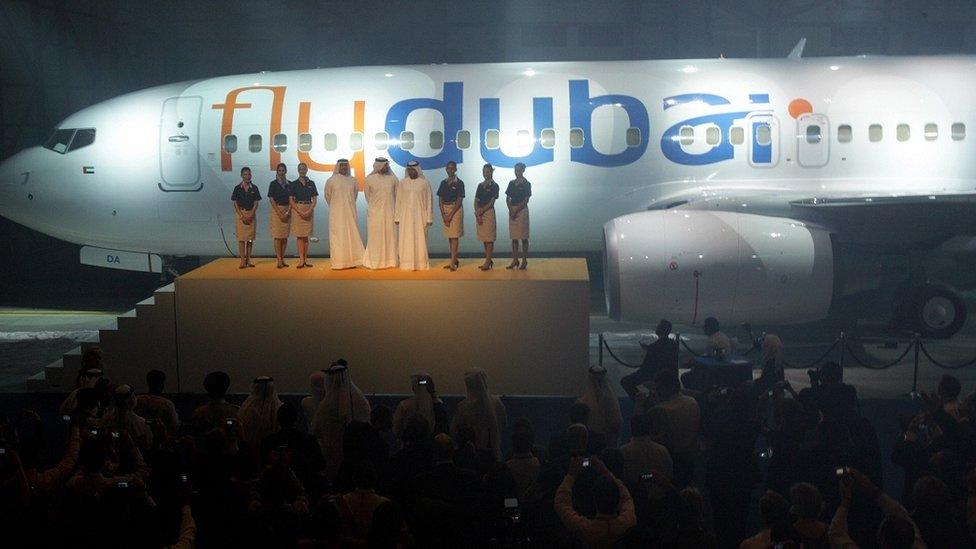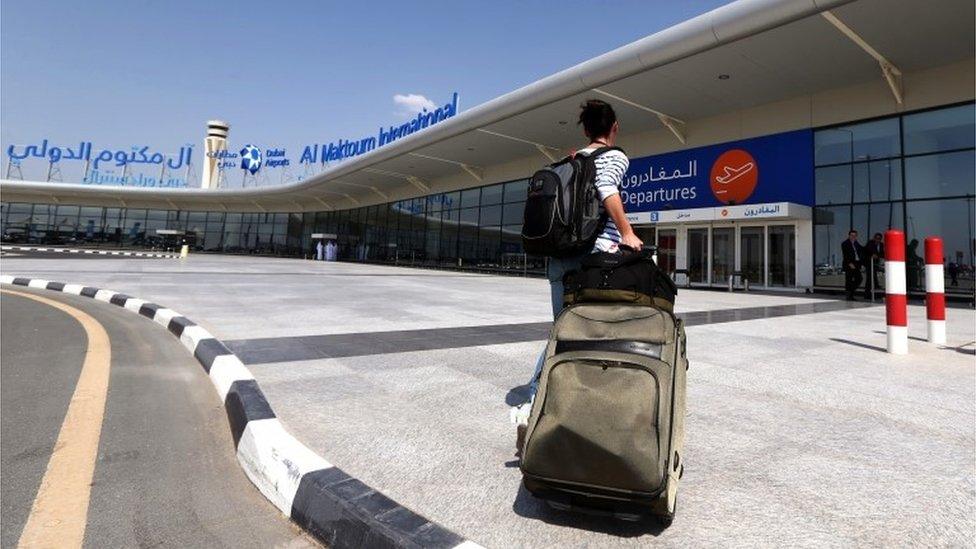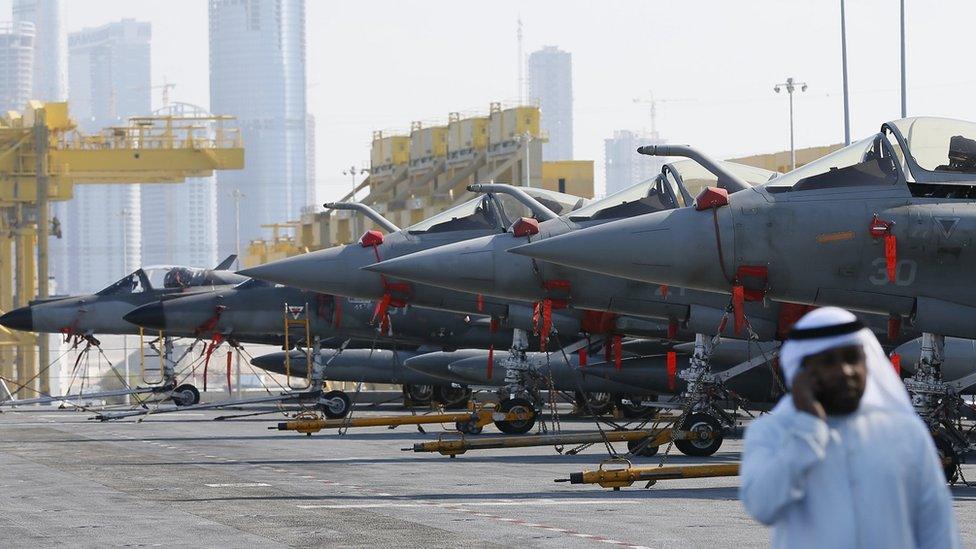Dubai Airshow: Crowded skies may limit airline growth
- Published

Flight delays will rise unless something is done about the Gulf's crowded airspace
The headline-grabbing aircraft orders expected at this week's Dubai Airshow will underline the rapid expansion of the Gulf's airlines.
Great news all round, you'd think. Except, concerns are rising that there is not enough airspace above the Gulf to cater for all these aircraft.
The problem is, the airspace above the Gulf is a patchwork of national air traffic controls and military restrictions, fragmented because of complicated historical and geopolitical reasons.
Aircraft congestion and rising delays was a big issue on the sidelines of the last Dubai show in 2013, when the likes of Emirates Airline and Qatar Airways notched up a record tally of $206bn (£135bn) in orders.
But there was also optimism among the authorities about cooperation and streamlining the system; there were plans, there was determination.
So, as the world's aerospace industry gathers for one of its set-piece events of the year, how are things progressing? Very slowly, it seems.
"We are seeing some signs of change," says John Swift, Middle East director at NATS, which runs the UK's air traffic services. "The frustration expressed by many people is that the pace of that change is too slow."
'Inconvenience'
It is a particular problem for the UAE, where Dubai and Abu Dhabi have positioned themselves as tourist destinations as well as 'hub' airports for travellers flying between east and west.

In addition to the Gulf's fast-expanding long-haul carriers, the region now has a thriving short-haul budget sector
In 2012, the number of aircraft movements through UAE airspace was more than 741,000, according to the International Air Transport Association (IATA). It's expected to reach almost 885,000 this year, with an average of 2,424 movements a day.
In 2020, movements are forecast to hit 1.2 million, and 1.85 million in 2030. Dubai's new Al Maktoum airport underlines the ambition. When fully open, it will be able to cater for 160 million passengers a year, against 75 million at the existing airport.
But Tony Tyler, IATA's director general, says there are signs that airlines are holding back on opening new routes because of airspace constraints.
"Growth is still ahead any air traffic changes," he says. "There are a lot of delays. There is inconvenience for passengers and added costs for airlines that have to circle before landing or take alternative routes."
Omar Bin Ghaleb, deputy director general of the UAE General Civil Aviation Authority (GCAA), recently described the sky above him as the most congested in the world.
A report from the GCAA concluded: "The current Middle East airspace structure will be unable to handle the sustained forecasted traffic growth within the UAE."
A study published in September by UK-based consultancy Oxford Economics - Economic Benefits of Improvements to Air Traffic Control , external- estimated that the average flight in the region was delayed by 36 minutes, and that 82% of those delays were due to air traffic control capacity and staffing issues.
By 2025, without air traffic control improvements, Oxford Economics forecast that the average delay would double to 59 minutes. The report also estimated that the region would lose out on $16.3bn of international trade and investment as a consequence.
Re-routing
Resolving the problem is impossible in isolation, says Mr Tyler. "The challenge is to look beyond merely national issues and focus on an even bigger picture, the strategic development of aviation across the entire Middle East.
"Harmonisation, integration and collaboration among aviation stakeholders is essential to realise the full potential of national projects."

When fully open, Dubai's new Al Maktoum airport will enable Emirates Airline to double in size
One positive development has been the expansion of the Middle East Airspace Enhancement Programme (MAEP), which tries to coordinate airspace policy, navigation, technological change and cooperation.
MAEP now has 15 member states, including Egypt, Kuwait, Oman, Bahrain, and newly-joined Iran.
There has been some agreement on re-routing, utilising in particular more airspace above the Empty Quarter, the vast desert in the Arabian Peninsula.
But beyond this there needs to be more agreement in the north east of the region, and particularly Iran, Iraq and Syria.
Just before the Dubai Airshow two years, a major study commissioned by the UAE aviation authorities into airspace improvements was submitted, with 51 recommendations.
None of the recommendations was made public, so it is unclear what, if anything, was implemented.
Now, the Arab Civil Aviation Commission has commissioned a report into air traffic congestion, covering the Gulf and North Africa.
And last month, UK management and technology consultancy Helios was asked by the six-member Gulf Cooperation Council, which includes UAE, Bahrain, Oman and Saudi Arabia, to look into the issue.
Military restrictions
Helios will initially focus on practical short-term changes to improve congestion, but the study will last about 15 months, the firm says.
"Investigations into the issue help, but you've got to act on the conclusions. That's been the problem in the past," says one airline executive, who asked not to be named.
The situation is especially frustrating for airlines, which have spent billions of dollars on the latest aircraft with the latest technology. The UAE has built a state-of-the-art air traffic management system.

The worsening security situation in the Middle East may have made some military authorities reluctant to discuss freeing up more airspace
But despite Gulf airlines' inextricable links with government, the executive says: "We cannot force the issue. There are complex structures and everything is siloed. Airlines have influence, but no one can force change."
A major impediment to change is that commercial aircraft are off limits to large areas of airspace used by the military.
In the Gulf, between 40%-60% of the airspace is reserved military use (in the UAE, it's about 50%), often leaving civil aircraft a narrow corridor through which to fly.
In Europe there is a more flexible approach. Civil and military air traffic controllers work together to ensure that the demands of both sides are met.
Some Middle East countries, including Jordan, have relaxed controls. But others must go much further.
"It's not about the military giving up airspace. It's about working more smartly," Mr Swift says.
It doesn't help that the worsening security situation in the Middle East has put the military on alert. "The conditions to have the discussions are just not ideal," Mr Swift says.
Nor does it help that for some countries aviation is not the core economic issue, especially for states earning huge oil revenues.
It's possible that falling oil prices may concentrate minds. But the key thing, Mr Swift says, is to convince governments that the sky above them is as much as economic resource as what is in the ground.